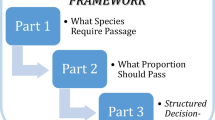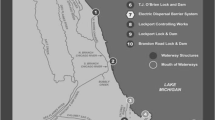Abstract
The United States Congress established Grand Canyon National Park in 1919 to preserve for posterity the outstanding natural attributes of the canyon cut by the Colorado River. In some cases National Park Service attempts to maintain Grand Canyon's natural environment have been thwarted by activities outside the park. One of the most obvious external threats is Glen Canyon Dam, only 26 km upstream from the park boundary. Constructed in 1963, this gigantic dam has greatly altered the physicochemical and biological characteristics of 446 km of the Colorado River in Grand Canyon National Park. The river's aquatic ecosystem has been greatly modified through the loss of indigenous species and the addition of numerous exotics. We consider this anexotic ecosystem. The riparian ecosystem has been less modified, with addition of a few exotics and no loss of natives—this we consider anaturalized ecosystem.
The great dilemma now faced by park managers is that, after 20 years of managing resources along a river controlled by Glen Canyon Dam, the Bureau of Reclamation has proposed major changes in operational procedures for the dam. Scientists and managers from the National Park Service, Bureau of Reclamation, and cooperating federal and state resource management agencies are using a systems analysis approach to examine the impacts of various Colorado River flow regimes on aquatic, riparian, and recreational parameters in the park. This approach will help in the development of management alternatives designed to permit the most efficient use of that river's natural resources without their destruction.
Similar content being viewed by others
Literature cited
Adams, V. D., and V. A. Lamarra (eds.). 1983. Aquatic resources management of the Colorado River ecosystem. Proceedings of the 1981 symposium on the aquatic resources management of the Colorado River Ecosystem, 16–18 November 1981, Las Vegas. Ann Arbor Science, Ann Arbor, Michigan, 697 pp.
Brown, B. T., S. W. Carothers, and R. R. Johnson. 1983. Breeding range expansion of Bell's Vireo in Grand Canyon, Arizona.Condor 85:499–500.
Carothers, S. W., and R. Dolan. 1982. Dam changes on the Colorado River.Natural History 91:74–83.
Carothers, S. W., and R. R. Johnson. 1975. Recent observations on the status and distribution of some birds of the Grand Canyon region.Plateau 47:140–153.
Carothers, S. W., and R. R. Johnson. 1983. Status of the Colorado River ecosystem in Grand Canyon National Park and Glen Canyon National Recreation Area. Pages 139–160in V. D. Adams and V. A. Lamarra (eds.), Aquatic resources management of the Colorado River ecosystem. Proceedings of the 1981 symposium on the aquatic resources management of the Colorado River ecosystem, 16–18 November 1981, Las Vegas. Ann Arbor Science, Ann Arbor, Michigan, 697 pp.
Carothers, S. W., and C. O. Minckley. 1981. A survey of the aquatic flora and fauna of the Grand Canyon. USDI Bureau of Reclamation, Lower Colorado Region, Boulder City, Nevada, 401 pp.
Christensen, E. M. 1962. The rate of naturalization of tamarix in Utah.American Midland Naturalist 68:51–57.
Dolan, R., B. Hayden, A. Howard, and R. Johnson. 1977. Environmental management of the Colorado River within the Grand Canyon.Environmental Management 1:391–400.
Dolan, R., A. Howard, and A. Gallenson. 1974. Man's impact on the Colorado River in the Grand Canyon.American Scientist 62:392–401.
Johnson, R. R. 1978. The Lower Colorado River: a western system. Pages 41–55in R. R.Johnson and J. F. McCormick (tech. coords.), Strategies for protection and management of floodplain wetlands and other riparian ecosystems. Proceedings of the Symposium. USDA Forest Service General Technical Report WO-12, Washington, DC, 410 pp.
Johnson, R. R., and S. W. Carothers. 1982. Riparian habitats and recreation: interrelationships and impacts in the Southwest and Rocky Mountain region. Eisenhower Consortium Bull. 12. Rocky Mountain Forest and Range Experiment Station, USDA Forest Service, Fort Collins, Colorado 31 pp.
Johnson, R., S. Carothers, R. Dolan, B. Hayden, and A. Howard. 1977. Man's impact on the Colorado River in the Grand Canyon.National Park and Conservation Magazine (March): 13–16.
Miller, R. R. 1946.Gila cypha, a remarkable new species of cyprinid fish from the Colorado River in Grand Canyon, Arizona.Journal of the Washington Academy of Science 36:409–415.
Nash, R. 1977. River recreation: history and future. Pages 2–7in D. W. Lime and C. A. Fasick (tech. coords.), Proceedings: river recreation management and research symposium. Forest Service General Technical Report NC-28, North Central Forest Experiment Station, St. Paul, Minnesota.
Paulson, L. J., and others. 1983. The influence of Lake Powell on the suspended sediment-phosphorus dynamics of the Colorado River inflow to Lake Mead. Pages 57–70 (plus six additional papers)in V. D. Adams and V. A. Lamarra (eds.), Aquatic resources management of the Colorado River ecosystem. Proceedings of the 1981 symposium on the aquatic resources management of the Colorado River ecosystem, 16–18 November 1981, Las Vegas. Ann Arbor Science, Ann Arbor, Michigan, 697 pp.
Ruffner, G. A., N. J. Czaplewski, and S. W. Carothers. 1978. Distribution and natural history of some mammals from the Inner Gorge of the Grand Canyon, Arizona.Journal of the Arizona-Nevada Academy of Science 13:85–91.
USDI Bureau of Reclamation. 1946. The Colorado River: a nautral menace becomes a national resource. Washington DC, 295 pp. +11 maps.
USDI National Park Service. 1968. Administrative policies for recreational areas of the National Park System. National Park Service, USDI, Washington, DC, 108 pp.
Valentine, S., and R. Dolan. 1979. Footstep-induced sediment displacement in the Grand Canyon.Environmental Management 3:531–533.
Author information
Authors and Affiliations
Rights and permissions
About this article
Cite this article
Johnson, R.R., Carothers, S.W. External threats: the dilemma of resource management on the Colorado River in Grand Canyon National park, USA. Environmental Management 11, 99–107 (1987). https://doi.org/10.1007/BF01867185
Issue Date:
DOI: https://doi.org/10.1007/BF01867185




